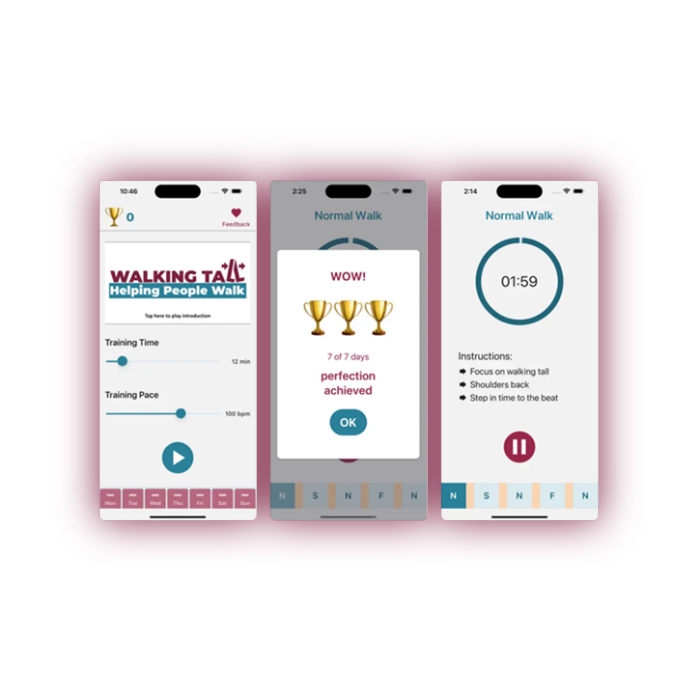Walking to a new beat

UNSW biomedical engineer, Associate Professor Matthew A Brodie, opens in a new window has developed a new app, which is helping tens of thousands of individuals combat difficulties in walking. With the help of research fellow and Director of Parkinson’s NSW, Martin Ostrowski, the two have focused their efforts on assisting those suffering from health concerns that impact their ability to walk. These include but are not limited to Parkinson’s disease, diabetes, stroke, heart failure, kidney disease, dementia and sleep issues. The “Walking Tall” app has been translated into multiple languages and made freely available for the worldwide community to use via the App Store, opens in a new window and Google Play, opens in a new window - with the aim of providing some immediate relief for people suffering from gait impairments.

A/Prof. Matthew Brodie and his Walking Tall app. Image courtesy of Matthew Brodie.
One foot in front of the other
There are more than 320 million people worldwide with treatable motor impairment. These health concerns are issues in their own right, but they can also lead to reduced physical exercise. “We wanted to create technology that could help people walk because insufficient physical exercise is a major risk factor for a number of conditions,” says Associate Professor Brodie.
“This is what’s inspired me to create research that one day could potentially help over 100-million people walk with confidence.”
The Walking Tall app, which initially received trial funding from the Michael J Fox Foundation, opens in a new window and Shake It Up Foundation Australia, opens in a new window, works by delivering a simple metronomic beat across three different walking speeds that have been designed to trigger movement. Further developments were made in partnership with the ARC Research Hub for Connected Sensors for Health (Connected Sensors Hub), opens in a new window and with the software team at UNSW’s Tyree Institute of Health Engineering, opens in a new window. With every-day use of the app, individuals can not only learn to walk better but walk for longer, reduce falls and improve overall mobility. “It’s giving hope to people through something that actually works now – and when we add new elements, it will be even more powerful,” says A/Prof. Brodie.

Walking Tall chief science officer Martin Ostrowski. Image provided by Matthew Brodie.
A personal connection
With his own history of Parkinson’s disease, Dr. Ostrowski has used his lived experience to help with the app’s development. “When I first came into contact with Matthew, I was running 35km a week but over time that degraded into less than 2km per week,” he explains. Following his participation in the app’s first trial, Dr. Ostrowski was able to return to running 35km a week within two months. What truly surprised him, however, was how his other health concerns also improved. “I’d had trouble with breathing but simply going out and walking gave me a chance to stand up straight and fill up my lungs,” he adds. “I had to learn how to walk and run again, but without the app I’m not quite sure where I’d be.”
The next step
The app, which was released in 2023, has already proven hugely popular with users, as well as industry peers and collaborators. “The work done by Matt Brodie and Walking Tall Health targets an incredibly serious global problem, namely difficulties with motor function and walking,” explains Professor Arun Krishnan – neurologist at Prince of Wales Hospital and member of the faculty of Medicine and Health at UNSW. “In most neurodegenerative conditions, there are no established methods of helping people to remain independent and ambulant, and while the early studies of the app have been undertaken in Parkinson’s Disease, there are a large number of conditions including diabetes and stroke in which this technology fills an important gap in treatment.”
Thanks to the app’s ongoing success, A/Prof. Brodie is now committed to the next phase and iteration of the project. This includes a wearable band solution that can be strapped to the users’ arms or ankles. In this instance, a prototype is to be attached to bands and worn above the ankles. The new device will work by synchronising neuronal stimulation across limbs, which has already been proven to help people with spinal cord injury regain function. “As a neurologist who sees these patients on a daily basis, I feel very optimistic about how this technology could improve health outcomes for patients with many neurological disorders,” adds Prof. Krishnan.
People who have diseases such as Parkinson’s have to concentrate on every single step when they walk. The bands help the wearer put one foot in front of the other without the need to focus so intensely on the act of walking. “I remember the first time I used the bands,” recalls Dr. Ostrowski. “I put them on, and I knew almost immediately that it was working, because instead of thinking about walking I was thinking about what I was going to cook for dinner that night.”
This new technology takes away the need to think about walking by providing stimulation matched to the intention of walking. “I’ve noticed people using this device who previously couldn’t walk and talk, turn around and joke to me while I’m asking them to concentrate on putting one foot in front of the other,” adds A/Prof. Brodie.
“I’ve noticed people using this device who previously couldn’t walk and talk, turn around and joke to me while I’m asking them to concentrate on putting one foot in front of the other,” adds A/Prof. Brodie.

Associate Professor Matthew Brodie and his band technology with Chris Louie, Director Digital, Cyber and Future Industry, Business Council of Australia at Parliament House in Canberra as a part of UNSW Founders delegation. Image courtesy of Walking Tall Health.
While the app provides the metronome beat and can measure how you’re walking, the bands work in combination with the app. “If you want the legs to move, you put the device on the legs. If you want the arm to move, you put it on your arms. The more you put on, the more effective it is,” explains A/Prof. Brodie.
One of his favourite new features however is being able to choose your own genre of music to walk to – an idea inspired by one of his regular app users. “We’re always thinking about how to direct our resources to where they’ll have the most benefit,” says A/Prof. Brodie. “Ideally, you direct it where people want it, which is called co-design, and this underpins everything we do at UNSW’s School of Biomedical Engineering, opens in a new window.”
The next step is to make the new technology available for widespread and sustainable community use and at an affordable price. This substantial research translation challenge has been tasked to UNSW Founders’, opens in a new window start-up Walking Tall Health, opens in a new window.
Sensing progress and progression
While the software and technology being developed by A/Prof. Brodie and Dr. Ostrowski is helping those with chronic conditions overcome their walking challenges, it’s also perfect for individuals recovering from knee or hip replacements.
The connected sensors can also help to track disease progression. “They’re sending feedback to the neurologist and physiotherapist, which allows them to customise intervention in real time and remotely look for red flags,” explains A/Prof. Brodie.
Importantly, preliminary analysis of participants using the new devices and phone app suggest there might be an added benefit of less falls by users.
“We’ve seen a staggering 300% reduction in falls and related injuries and noticed that people are exercising 2.5 times longer than usual,” says A/Prof. Brodie.
“They’re now breaking 150-minutes per week of exercise, which aligns with the World Health Organisation (WHO) recommended minimum to prevent falls and chronic co-morbidities.”
Making strides in general health
The far-reaching impact of the app has been hugely rewarding for both men. “I’ve been a scientist for more than 25 years but being able to work on something that has direct impact is really attractive,” says Dr. Ostrowski. “The moment you start walking well, everything gets better.”
Hero image: The Walking Tall app, which is free and available on iOS, opens in a new window or Android, opens in a new window.
Image courtesy of Matthew Brodie.
Share this story
Read more
Get in touch and see what’s possible.
Ask how we can help your business, industry, or market through collaboration.



